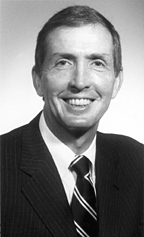
Ask John Olson C’64 WG’66 what it was like being publicly skeptical of the Enron Corporation in a city like Houston, and he replies: “Well, let’s say that it’s a little bit of a wilderness when you’re out there alone.” But, he adds, “It was more being skeptical of Wall Street than of Houston.”
Olson is senior vice president and director of energy research at the Houston-based investment firm of Sanders Morris Harris, and while it wasn’t his longstanding professional skepticism that punctured the giant energy firm’s hot-air balloon, it did get under the skin of its now-disgraced chairman and CEO, Kenneth Lay.
Last June, for example, when Enron was still dazzling Wall Street with its high-wire shell game, Olson told U.S. News & World Report that Enron was “not very forthcoming about how they make their money,” and added: “I don’t know an analyst worth his salt who can seriously analyze Enron.”
Lay’s response came in the form of a handwritten note to Olson’s boss, Donald Sanders. “John Olson has been wrong about Enron for over 10 years and he is still wrong,” Lay had scrawled in the margins of the U.S. News story. “But he is consistant [sic].” It was signed, “Ken.”
According to The New York Times, when Sanders showed him the note, Olson replied, “You know that I’m old and worthless, but at least I can spell consistent.”
Though Lay’s note “probably created the opposite effect of what he intended,” Olson says, it was just one example of the “gamesmanship” the company would use to discourage naysayers.
“They were very combative; they enjoyed playing hardball; and usually made their point: money buys people; more money buys more people. And this has had a natural backlash on securities analysts, accountants, and lawyers. Because all of the normal protections were breached.”
But while Enron may have “gamed” Wall Street, the auditors, and the lawyers, he says, it also had a “group of people operating inside the company which managed to game Enron. What took this company down was a combination of rogue financing and rogue accounting. Enron’s basic trading business was basically fine. But it ended up with nearly one third of its assets not-performing. And that became too big of a burden to bear or hide.
“Enron was far and away the biggest business success on the Internet,” Olson adds. “Through its trading operation, no one else came close to them. But they spent it all away in these misbegotten diversifications. Wall Street was enamored by its successful trading record and its successful adoption of Internet trading or online trading, and gave it enormous valuations in comparison to the rest of their competitors. That created a bubble mindset of the company that they could make up their own rules and live happily ever after.”
Olson’s own approach appears to have been doggedly consistent and resistant to hype. “Always invest in only those things you understand,” he told Knowledge@Wharton, the Wharton School’s biweekly online business newsletter, recently. “Invest only in companies that are making money.” And be wary of companies that trade at astronomically high price-earnings ratios—as Enron was. “They trade at 44 times earnings, and the rest of the pack trade at about 20 times,” he told TheStreet.com’s Christopher Edmonds in January 2001. “They would argue they are unique. I would say nothing in life is that unique.”
“If a company stock price goes up exponentially, the company ego goes up exponentially,” he says now. “This was very apparent on Wall Street. Enron had a great 1990s; they were one of the shining stars of the entire decade, and what originally was fine performance became a cover for some awful investing blunders. They disguised those blunders simply because they didn’t want to appear stupid.
“Investing becomes a very simple business if you follow the rules,” says Olson, adding that his Wharton professors—including the late Dr. James Walter, Dr. Willis Winn Gr’51 Hon’72, and Dr. Morris Mendelson—were “very good guides to learning what is important in valuing companies.” Back when he was breaking into the securities-analysis business in the late 1960s, he recalls, “if an investment banker came into my boss’s office to give a strong ‘buy’ recommendation, he would get thrown out immediately, maybe even fired from the firm.” He quotes another analyst who said: “Today, what was formerly perceived as a conflict, is now perceived as a synergy.” And that conflicted synergy, he maintains, has “debased the currency of securities analysis.”
Out of the Enron debacle, he predicts, will come a number of long-needed reforms and requirements, including “much stronger balance sheets for energy trading companies, more conservative credit ratings, much stricter accounting treatments for energy trading, much greater disclosure, and, last and not least, a hope for housecleaning on Wall Street to get investment banking out of research.”
Today, Olson admits that he is finally getting his “15 microseconds” of fame. Admiring profiles in The New York Times, requests from Mike Wallace to appear on 60 Minutes, and, of course, the much-awaited interview with the Gazette. But while he’s acknowledging the vindication of being proven right, he can’t find it in his heart to gloat.
“This is a situation where it’s had an unhappy ending for just about everybody,” says Olson. “A lot of good people at Enron thought that what they were doing was blessed by all the lawyers, accountants, and bankers—and they’ve had a rude awakening. And this has turned out to be a media storm that has consumed just about everybody. And the truth, unfortunately, will be coming out in the courtroom.”

